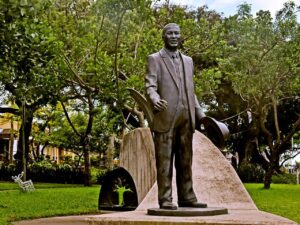[imagesource: Patrick McMullan]
We’ve all become rather accustomed to the classic rise and fall cautionary tale of “serial swindlers” who eventually get taken down by their own greed.
Beginning with America’s most notorious conman, Bernie Madoff, and bookmarked (because these Ponzi schemes will never truly end) with the art industry’s worst, 34-year-old British-born dealer, Inigo Philbrick.
We heard about the so-called “boy wizard of the art world” in 2020 when he had been arrested in designer swimming trunks that he swapped out for secondhand trousers as he was due to appear in court.
Well, the disgraced Justin Timberlake lookalike has now been sentenced to seven years in US prison (he is a US citizen) after pleading guilty to an $86 million wire fraud in November.
He has also been ordered to cough up a “forfeiture of $86 672 790” – the amount that he had fraudulently obtained through his various schemes.
His charms and talent were overshadowed by what one of his victims, Kenny Schachter, described as “a toxic mix of arrogance and alcohol”.
Schachter, an American artist, academic and writer, lost more than $1,5m to Philbrick, The Guardian reported:
“He misappropriated my funds, my art, like he did with many people,” he says.
What makes it all the more painful is that they were once friends, close enough to have holidayed together, and he remembers Philbrick as a “very talented art dealer” who was “sharp, fun and funny”.
There were also drugs involved, which began when Philbrick was at school and “intensified as he entered London’s art world”, according to Philbrick’s lawyer Jeffrey Lichtman.
He added that this was “how art deals are done”.

At least Philbrick was honest when Judge Stein asked him why he committed the crime, answering that it was all “for the money, your honour”:
The suave American dealer, with a gallery at an exclusive London address, a Midas touch that brought soaring profits in art sales and a socialite girlfriend from Made in Chelsea, had in fact been running a fraudulent business.
…His was a smoke-and-mirrors trade that involved selling a total of more than 100% of an artwork to multiple investors without their knowledge, using works as collateral on loans without informing their co-owners, and falsifying documents to inflate artwork values, with one contract listing a stolen identity as the seller, according to the US Department of Justice.
It is believed that this fraudulent scheme operated between 2016 and 2019, and included Jean-Michel Basquiat’s 1982 painting Humidity and Rudolf Stingel’s 2012 photorealist-style portrait of artist Pablo Picasso.
Philbrick’s crimes funded his life of luxury, where he was able to travel on private planes and drink the finest wines at £5 000 a bottle.
But finally, the law caught up with him after a lender officially notified Philbrick that he was in default of a $14 million loan.
At that stage, various victims who weren’t seeing a single return on their investments had also filed civil lawsuits. Philbrick’s subsequent escape to a remote Pacific island didn’t do him any favours and he was arrested.
One does not play games with other people’s money for very long.
[source:guardian]





